Best repertoire and composer for piano technical development?
Browse in the Library:
and subscribe to our social channels for news and music updates:
Czerny, Clementi, Burgmüller, Hanon, Heller, Bartók, Moszkowski, Chopin, Debussy, Berens?
Carl Czerny
Carl Czerny (1791-1857) was born in Vienna into a Czech family, and had his first piano lessons from his father. Carl developed quickly, and by ten he was “able to play cleanly and fluently nearly everything by Mozart and Clementi” (Erinnerungen aus meinem Leben, Czerny´s autobiographical sketch from 1842). He was then introduced to Beethoven, who accepted him as his pupil. Czerny would prove very useful to his teacher over the years as an outstanding interpreter of Beethoven´s piano works. He also wrote valuable commentaries on the performance of Beethoven´s piano music.
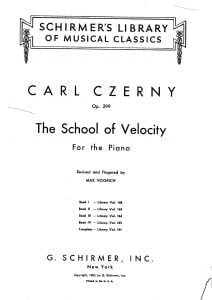
Czerny did not undertake the life of a travelling virtuoso, but chose instead to dedicate himself to teaching and composing, his most famous pupil being Franz Liszt. When Clementi was in Vienna in 1810, Czerny spent a great deal of time with him, becoming familiar with Clementi’s piano method and incorporating it into his own teaching.
Czerny often taught ten hours a day, but nevertheless found time to compose more than a thousand works. He is mainly known for his many sets of studies and exercises for piano, especially the School of Velocity, Op. 299. Czerny’s complete schools and treatises combine sound pedagogy with remarkable revelations about contemporary performing practices, and present a detailed picture of the musical culture of the day.
His most substantial work in this vein, the Pianoforte-Schule Op. 500, covers an extraordinary range of topics, including improvisation, transposition, score reading, concert decorum and piano maintenance.
In the 1840s, Czerny’s health began to fail. His enormous productivity had earned him a respectable fortune which, on his death, he left to various charities, including (as a tribute to his teacher Beethoven?) an institute for the deaf.
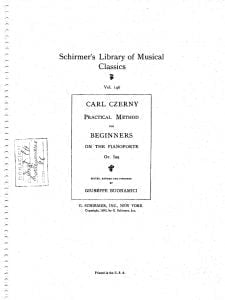
The predominant view of Czerny as a zealous pedagogue, producing an endless stream of dry and unimaginative works, might have its origin in Robert Schumanns many bad reviews of his music. However, not everyone at the time-shared Schumanns unfavourable opinion. Czerny was held in high regard by many, including Liszt and Chopin, and as the teacher and mentor of many important musicians he remains a central figure in the transmission of Beethoven’s legacy.
Czerny Op.599 (Complete)
Sheet Music Download here.
Muzio Clementi
Muzio Clementi (1752-1832) was born in Rome, the eldest of seven children. He was taught the basics of music by the local church choirmaster. Later he started learning the organ, and made such sensational progress that he obtained a position as church organist when he was still in his early teens.
In 1766 Clementi was taken to England by the wealthy Englishman Sir Peter Beckford, who provided for his lodging and musical education in return for musical entertainment at his estate in Dorset. His public debut as a pianist a few years later was a tremendous success. He moved to London, where he performed frequently as a soloist and directed concerts from the keyboard. Later, he went on tour as far as St. Petersburg, and by the 1780s he was considered one of the great keyboard virtuosos of the world.
His reputation irritated Mozart, who described him as a charlatan. Clementi, on the other hand, was a real admirer of Mozart, but developed a completely different piano style, with great dynamic contrasts, rapid octaves and thundering arpeggios, paving the way for Beethoven and the romantics.
A piano contest between Clementi and Mozart in Vienna was more or less declared a draw. Clementi led a very productive life in London, playing, conducting, teaching (his pupils include J. B. Cramer and John Field) and manufacturing pianos.
Eventually he abandoned his performing career to spend more time building pianos and composing. His works include vocal and chamber works, symphonies, a piano concerto, and over a hundred piano sonatas and sonatinas. The easier sonatinas and his three volumes of studies called Gradus ad Parnassum have been central to piano teaching ever since. His other works have suffered from widespread neglect, perhaps because of Mozart’s unkind comments.
Vladimir Horowitz was one of the very few major pianists of the 20th century who appreciated Clementi’s music – since his time the composer has slowly begun to attract more interest. Clementi died a very rich man, and was buried in Westminster Abbey.

Mozart (letter to his father): “Clementi plays well, as far as execution with the right hand goes. His greatest strength lies in his passages in 3rds. Apart from that, he has not a kreuzer’s worth of taste or feeling – in short he is a mere mechanicus”.
Clementi – Gradus Ad Parnassum: Complete Piano Studies
Friedrich Burgmüller
Johann Friedrich Franz Burgmüller (1806-1874) was born in Regensburg, Germany. His father was a composer and musical theater director and founded the Lower Rhine Festival, still an important musical event in Germany.
Friedrich’s brother Norbert was also a pianist and composer, probably even more talented than his brother and father, but lacking their ambition and sociability. After studying with Ludwig Spohr and Moritz Hauptmann, Burgmüller moved to Paris, where he stayed until his death. There he developed his trademark, light style of playing and became a fashionable writer of songs and salon pieces for piano.
He also composed works for the stage, including the ballet La Péri. Burgmüller also went on to publish several albums of descriptive piano studies, mostly intended for children, that have become standard works and are very popular to this day. In particular, selections from his Op. 68, 76, 100, 105 and 109 and his “Ballade” have appeared in various educational anthologies. The twenty-five studies Op. 100 include some of his most popular works, and the later opus numbers contain some more demanding studies.
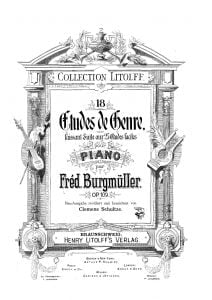
Apart from these piano pieces, Burgmüller’s most often performed piece is the so-called Peasant Pas de Deux added to the ballet Giselle for its 1841 premiere. This music was originally titled Souvenirs de Ratisbonne, and is still performed today in every production of Giselle.
Burgmuller Op.100 25 Easy and Progressive Studies (Complete)
Charles Louis Hanon
Born into a devout Catholic family in Renescure, France, Charles Louis Hanon (1819-1900) studied music with a local organist. He settled in Boulogne and worked for a while as a choirmaster and organist. He taught singing and piano privately and eventually started to publish his own compositions. Hanon led a devotedly religious and charitable life but at the same time showed a marked aptitude for business. His works all have a didactic or sacred purpose.
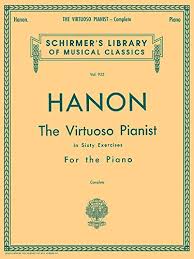
It is for Le piano virtuose (The Virtuoso Pianist), a set of 60 technical exercises, that he is chiefly remembered. Published in Boulogne in 1873 this work has been frequently reprinted and is still widely used. The exercises are arranged in three parts – preparatory exercises, further exercises and virtuoso exercises – and are meant to be played consecutively in the sections they are placed in, to help increase endurance as well as technical ability. After all three parts are mastered, Hanon recommends all exercises be played through daily to retain technique.
Hanon Exercises No.1-60 (Complete) ハノン 哈農 哈农
Stephen Heller
Stephen Heller (15 May 1813, Pest, (now Budapest, Hungary) – 14 January 1888, Paris, France) was a Hungarian composer and pianist whose career spanned the period from Schumann to Bizet, and was an influence for later Romantic composers. Heller had been destined for a legal career, but instead decided to devote his life to music.
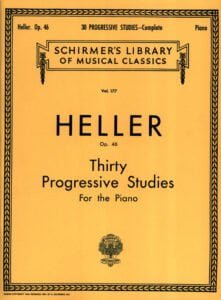
At the age of nine, he performed Dussek’s concerto for two pianos with his teacher, F. Brauer, at the Budapest theater. He played so well that he was sent to study in Vienna, Austria, under Carl Czerny. Unable to afford an expensive fee by Czerny, Anton Halm became his principal master. After a success in the first public concert in Vienna at the age of 15, his father undertook a concert tour through Hungary, Poland and Germany.
Heller: Piano Studies
Béla Bartók
Béla Bartók (1881-1945) was born in the small provincial town of Nagyszentmiklós, then Hungary (now Sânnicolau Mare in Romania). He received his first piano lessons from his mother, and showed great talent already at four years of age. He later studied piano and composition at the Budapest Royal Academy of Music.
In 1902, he met Richard Strauss at the Budapest premiere of Also sprach Zarathustra, and about one year later Bartók’s own grandiose and nationalistic tone poem Kossuth was premiered. By this time, Bartók was also a renowned piano virtuoso, travelling abroad performing music of Liszt and other romantic composers. But when he became professor of piano at the Budapest Royal Academy, he more or less abandoned this career and spent more time composing and collecting folk songs from different parts of the world.
Together with fellow composer Zoltan Kodály, he had systematically been collecting and recording Hungarian folk music, and now he went on to visit Turkey and parts of North Africa. In spite of Bartók’s preoccupation with Hungarian folk music, his work was at not at all appreciated by his own people. In the rest of Europe, however, his fame was rising quickly. Apart from the influence of folk music and the romantic heritage from Liszt and Brahms, Bartók also adapted for his own purposes the methods of his contemporaries Strauss, Debussy and Stravinsky.
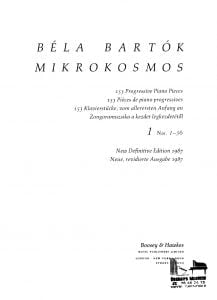
The events of World War II forced Bartók to flee Hungary and emigrate to the USA. The fact that he was relatively unknown in this country, together with his failing health and a difficult financial situation, made Bartok´s last years unhappy.
In 1945, he died of leukemia and was buried in New York. After the fall of Hungarian communism in 1988, his remains were transferred to Budapest to be given a full state funeral.
Béla Bartók – Three Études for piano, Op. 18 with sheet music
Bartok – Mikrokosmos (complete, 6 vol. with sheet music)
Moritz Moszkowski
The pianist and composer Moritz Moszkowski (1854-1925) was of Polish descent, but settled in Berlin after studying there and in Dresden. A celebrated virtuoso, he toured extensively as a concert pianist, before eventually retiring to Paris.
His catalog of works includes, apart from over two hundred small-scale piano pieces, a symphonic poem, an opera, and a ballet. The Spanish Dances, Op. 12, were his most celebrated works; they have been issued in several arrangements.

Ignacy Paderewski said: “After Chopin, Moszkowski best understands how to write for the piano, and his writing embraces the whole gamut of piano technique.”
Moszkowski Étude in F major, Op 72 No 6 with sheet music
Frédéric Chopin
Both in terms of harmony and piano technique, Chopin invented a completely new style, always instantly recognizable, and with far-reaching influences. Few composers command such universal love – above all for the unique charm of his lyrical, floating melodies. But Chopin’s style is also one of great energy and virtuosity, joy and humor, philosophical reflection, and raging storms. Many works contain an element of nostalgia and sorrow, born out of the exiled composer’s longing for Poland.
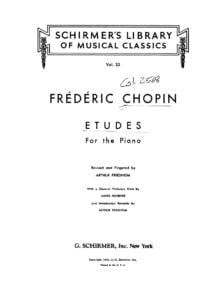
Brought up in Warsaw by a Polish mother and a French father, Frédéric Chopin (1810-1849) was more or less self-taught as a performer. Even his first teacher Wojciech Zywny didn’t have much to offer him in terms of technique, but still did his pupil a great service by introducing him to Bach and Viennese Classicism. Later, Chopin received thorough training in composition at the High School of Music in Warsaw.
Around his twenties, he grew increasingly troubled about his future – he loved his native country, but at the same time deplored the provincialism of it. He embarked on a European tour, still doubting the path of public pianist-composer and resenting the extreme publicity surrounding his concerts.
One week after arriving in Vienna, he had news of the Warsaw uprising against the Russian rulers. Chopin would have liked to return immediately, but was dissuaded by friends pointing out that his contribution to the Polish cause could best be made in other ways. The Russians were victorious, which made a return to Poland impossible; Chopin continued to Paris. From the start he felt at home there, not least because there were Polish émigrés everywhere, but also because he was overwhelmed by the city’s cultural life.
He made friends with other young artists, including Liszt and Berlioz, and with the help of Frédéric Kalkbrenner arranged his first Parisian concert early in 1832. In the following years his reputation grew steadily, and he settled into a stable routine of teaching, composing and performing, mostly in the intimate setting of the salons.
In 1838 Chopin began his love affair with the novelist George Sand; together they spent the winter months of 1838–9 in Majorca. This proved an ill-considered venture: their accommodation was quite unable to withstand the harsh winter, and Chopin’s already fragile health worsened. During the first half of the 1840s, Chopin would spend the summers composing in Sand’s home in Berry, but work became increasingly slow and laborious as his health deteriorated further.
Chopin: Etudes Op.10 and Op.25 (Fialkowska)
In 1846, the relationship with Sand came to an end; her novel Lucrezia Floriani, published the same year, was blatantly autobiographical and far from flattering to Chopin. In his last year, he managed to make a tour of the British Isles; after his return, as the word quickly spread that he was dying, friends and acquaintances gathered constantly around him. Pauline Viardot remarked cynically that “all the grand Parisian ladies considered it de rigueur to faint in his room.” He died in the presence of his pupil Adolphe Gutman and Sand’s daughter Solange.
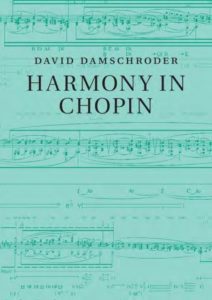
“Simplicity is the highest goal, achievable when you have overcome all difficulties. After one has played a vast quantity of notes and more notes, it is simplicity that emerges as the crowning reward of art.”
“Mould the keyboard with a velvet hand. And feel the key rather than striking it. Since each finger is individually shaped, it is best not to seek to destroy the particular charm of each, but to develop it. As many different sounds as fingers.”
F. Chopin
Hermann Berens
Hermann Berens (7 April 1826 in Hamburg – 9 May 1880 in Stockholm) was a German-born Swedish Romantic composer famous mainly for his piano music, some of which is included in the Royal Conservatory of Music’s Syllabus.
He was the son of a flute player from Germany. One of his popular pieces is Study in A minor, Op. 61, No. 32.
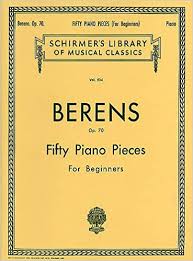
In 2006, the Trio ZilliacusPerssonRaitinen recorded Berens’s three string trios, Op. 85, and the recording was released by the Intim Musik label (a Swedish company) in 2007. The booklet enclosed with the recording includes a detailed biographical note on the composer.
Berens : Etude in A minor, Op. 61, No. 13
Claude Debussy
Debussy represents the beginning of the modern era, and not just in the classical sphere – he also profoundly influenced 20th-century popular music and jazz. He abandoned traditional theory and made ‘pleasure’ his only law, looking to poetry and painting for inspiration. By putting familiar chords in unfamiliar sequences, favoring ancient and exotic scales, and focusing on texture and color, he created sounds that appear to be happening by magic rather than being written down.
Although he himself wished to reserve the term for the visual arts, Claude Debussy (1862-1918) has often been considered the founder of musical Impressionism. Indeed, he added a quite new range of timbre and color to western classical music. When graduating from the Paris Conservatory, he won the prestigious Prix de Rome, which financed two years of further study in the Italian capital, where he had the opportunity to meet Franz Liszt.
He also made two trips to Wagner’s Bayreuth. Back in Paris, he became a frequent participant at Stéphane Mallarme’s symbolism gatherings and formed friendships with many leading Parisian writers, musicians and artists.
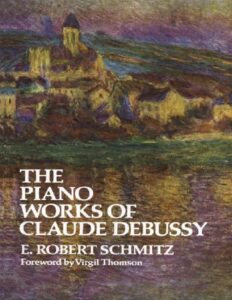
At the Universal Exposition of 1889 he became fascinated by the music of eastern cultures, especially the Javanese gamelan, a discovery that made him want to get away from Wagner’s influence. The year 1894 saw the sensational premiere of his Prélude à l´après-midi d´un faune, immediately launching Debussy into the spotlight as one of the leading composers of the era. The opera Pelléas et Mélisande made a similar impact, and caused a lasting division among Paris audiences between the forward-looking believers in “Debussyism” and those who failed to appreciate his style.
Debussy cohabited in Paris with Gabrielle Dupont for nine years before marrying her friend Rosalie Texier, a fashion model, in 1899. Increasingly irritated by Texier’s lack of intellectual and musical interest, Debussy left her for Emma Bardac, the wife of a Parisian banker and an accomplished singer. Texier, like Dupont before her, attempted suicide. The scandal obliged Debussy and Bardac (already carrying his child) to flee to England until the hysteria subsided. The couple were eventually married in 1908.
Debussy spent his remaining years immersed in French musical society, writing as a critic, composing, and performing as pianist and conductor. The war depressed Debussy into a state of creative sterility, but the summer of 1915 marked the start of a new productive era: in quick succession he composed the Cello Sonata, En blanc et noir, the Études, and the Sonata for flute, viola and harp.
Debussy “Doctor Gradus ad Parnassum” Paul Barton, FEURICH HP piano
Unfortunately, at the end of the year he had to undergo a debilitating colostomy for rectal cancer, one of the very first such operations. Many of his planned projects remained unrealized, but he managed to complete the Violin Sonata in 1917. He died in Paris during the bombardment of Paris in the last German offensive of World War I.
“There is no theory. You merely have to listen. Pleasure is the law.”
“Music begins where words are powerless to express. Music is made for the inexpressible. I want music to seem to rise from the shadows and indeed sometimes to return to them.”
Claude Debussy
One last thought
All the above-mentioned Piano technical exercises, études and scales are perfect, even maybe necessary for the performer expertise development. However, some composers are more “enjoyable” than others (f.i., Chopin, Burgmüller). Also, playing “easy” (but really not so easy) piano sonatas by Beethoven and Mozart, give the chance to practice many piano technical aspects and, at the same time, to enjoy beautiful pieces (f.i., Beethoven Sonata Op. 49 No. 2, and Mozart Sonata KV 545).
Beethoven: Sonata No.20 in G Major, Op.49 No.2 (Goode, Lewis)
Mozart – Piano Sonata No. 16 “Sonata semplice”, K.545 (1788) {Ingrid Haebler}
Browse in the Library:
and subscribe to our social channels for news and music updates: